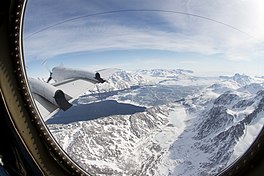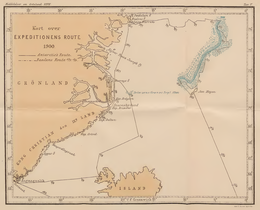Kangerlussuaq Fjord, East Greenland
| Kangerlussuaq Fjord | |
|---|---|
| Storfjord | |
 View of the head of the fjord and the terminus of the Kangerlussuaq Glacier | |
| Location | Arctic |
| Coordinates | 68°25′N 32°26′W / 68.417°N 32.433°W |
| Ocean/sea sources | North Atlantic Ocean |
| Basin countries | Greenland |
| Max. length | 68 km (42 mi) |
| Max. width | 9.7 km (6.0 mi) |
| Average depth | 960 m (3,150 ft) |
| Settlements | Storfjord Station, abandoned |
Kangerlussuaq Fjord (Greenlandic: Kangerlussuaq, meaning 'large fjord'; Danish: Storfjord) is a fjord in eastern Greenland. It is part of the Sermersooq municipality.
The fjord was named by the East-Greenland Coast Expedition led by Georg Carl Amdrup in 1900. Currently drilling explorations are being carried out for the possible exploitation of gold, palladium and platinum in the Kangerlussuaq area.[1]
History
[edit]The eastern coast of Greenland was inhabited by Paleo-Eskimo people 4000 years ago and the Kangerlussuaq Fjord was likely visited by hunters. A quartz hand scraper found in Cape Irminger —24 km east of Cape Hammer— proves that the region was visited at least 2000 years ago.[2] Inuit lived in the area between the late 13th century and the early 19th century.[3]
Remains of Inuit dwellings were found in 1900 when the first Europeans reached this remote fjord during Georg Amdrup's East-Greenland Coast Expedition. However, the first archaeological excavations on the Skaergaard intrusion were carried out by members of the Second East-Greenland Expedition of the Scoresbysund Committee led by Ejnar Mikkelsen in 1932.[3]
On the occasion of the Second International Polar Year in 1932 a Norwegian weather and radio station named "Storfjord/LMR"[4] began operations at Mud Bay (Mudderbugten) on the southwest side of Kangerlussuaq Fjord. The station ceased operations in 1933.[5][3]
In 1945 there was a hunters colony near the mouth of the fjord and a US run weather station was established on the Skaergaard intrusion. The weather station was moved in 1949 to North Apulileeq (Nordre Aputiteq) island, located about 45 km to the southwest off Cape Edvard Holm.
Geography
[edit]This fjord is located in King Christian IX Land, roughly midway between Scoresby Sound and the Sermilik Fjord and marks the southern limit of the Blosseville Coast. It is the second-largest fjord in the southeastern coast of Greenland. Its waters are fed by the huge Kangerlussuaq Glacier, the largest glacier on the east coast of the Greenland ice sheet, among other not so large active glaciers such as the Hutchinson Glacier near its southern entrance. The fjord stretches inland in a roughly NW direction and its mouth is located between Cape Deichmann and Cape Hammer in the Denmark Strait area of the Atlantic Ocean.[6]
The Nordfjord, Courtauld Fjord, Amdrup Fjord (Atterteq) and Watkins Fjord (Torsukattak) are smaller side fjords within the Kangerlussuaq Fjord system.[7] Kraemer Island lies at the entrance of Watkins Fjord, separated from the Skaergaard intrusion on the northern shore of Kangerlussuaq Fjord by the narrow Uttental Sund. Kangerlussuaq Fjord is a deep fjord with strong and dangerous currents.[8]
Mountains
[edit]Near the fjord's entrance its sides widen, forming an impressive bay surrounded by towering cliffs and high mountains, such as the 1,660 m high Batbjerg to the northwest[8] and the mountainous upland of the Nordfjord Plateau to the northeast.[9] The Redekammen and the Kangerlussuaq Tinde are nunataks located to the west, the Prince of Wales Range (Prinsen af Wales Bjerge) is located to the north[10] and the Lemon Range to the east of the fjord.[11] The Crown Prince Frederick Range stretches southwestwards to the southwest of the fjord.[12]
 |
 |
Geology
[edit]The area around Kangerlussuaq has been known for its unique geology since the 1930s regarding the many intrusions where magma from the Earth's interior has been forced into the Earth's crust. The Skaergaard intrusion that was discovered by Lawrence Wager in 1931 during the British Arctic Air Route Expedition is especially well-known.[13]
Climate
[edit]Tundra climate prevails in the region of the fjord. The average annual temperature in the Kangerlussuaq Fjord area is -11 °C . The warmest month is July when the average temperature rises to 2 °C, and the coldest is March, with -18 °C.[14]
| Climate data for Apulileeq, elevation: 12 m, 1961-1990 normals[a] | |||||||||||||
|---|---|---|---|---|---|---|---|---|---|---|---|---|---|
| Month | Jan | Feb | Mar | Apr | May | Jun | Jul | Aug | Sep | Oct | Nov | Dec | Year |
| Mean daily maximum °C (°F) | −7.0 (19.4) |
−7.6 (18.3) |
−7.7 (18.1) |
−3.5 (25.7) |
1.3 (34.3) |
3.8 (38.8) |
5.3 (41.5) |
5.3 (41.5) |
3.0 (37.4) |
−0.6 (30.9) |
−4.4 (24.1) |
−6.4 (20.5) |
−1.5 (29.2) |
| Daily mean °C (°F) | −10.8 (12.6) |
−11.4 (11.5) |
−11.6 (11.1) |
−7.2 (19.0) |
−1.9 (28.6) |
1.0 (33.8) |
2.2 (36.0) |
2.4 (36.3) |
0.7 (33.3) |
−2.6 (27.3) |
−6.9 (19.6) |
−9.6 (14.7) |
−4.6 (23.7) |
| Mean daily minimum °C (°F) | −15.1 (4.8) |
−15.6 (3.9) |
−15.7 (3.7) |
−11.0 (12.2) |
−5.0 (23.0) |
−1.3 (29.7) |
−0.4 (31.3) |
0.0 (32.0) |
−1.2 (29.8) |
−4.4 (24.1) |
−9.6 (14.7) |
−13.0 (8.6) |
−7.7 (18.2) |
| Average precipitation mm (inches) | 57.0 (2.24) |
56.0 (2.20) |
50.0 (1.97) |
51.0 (2.01) |
45.0 (1.77) |
78.0 (3.07) |
32.0 (1.26) |
95.0 (3.74) |
76.0 (2.99) |
68.0 (2.68) |
61.0 (2.40) |
39.0 (1.54) |
708 (27.87) |
| Average precipitation days (≥ 1.0 mm) | 9.0 | 9.0 | 8.0 | 8.0 | 7.0 | 7.0 | 5.0 | 8.0 | 7.0 | 10.0 | 8.0 | 7.0 | 93 |
| Average relative humidity (%) | 80.0 | 80.0 | 80.0 | 80.0 | 85.0 | 88.0 | 87.0 | 85.0 | 80.0 | 79.0 | 79.0 | 79.0 | 81.8 |
| Source: NOAA[15] | |||||||||||||
See also
[edit]Bibliography
[edit]- Therkel Mathiassen (1934), Eskimo finds from the Kangerdlugssuaq region, København: C.A. Reitzel., OCLC 6335533
Notes
[edit]- ^ Except for precipitation days nad fail (snow or rain) that have the measurement period of 1961-1979 (18 years).
References
[edit]- ^ Project Update and Activities (PDF; 1,9 MB), Platina Resources Ltd., 26. Februar 2014 (englisch)
- ^ Christian Glahder: Hunting in Kangerlussuaq, East Greenland, 1951–1991. An Assessment of Local Knowledge (= Meddelelser om Grønland, Man & Society, Nr. 19, 1995), p. 12
- ^ a b c Skaergaard history
- ^ 'Kystradio - Stasjonshistorie
- ^ Norwegian Polar Year and Radio Stations in East Greenland, 1932–33
- ^ "Kangerlussuaq". Mapcarta. Retrieved 11 April 2016.
- ^ Christian Glahder: Hunting in Kangerlussuaq, East Greenland, 1951–1991. An Assessment of Local Knowledge (= Meddelelser om Grønland, Man & Society, Nr. 19, 1995), p. 10 (englisch)
- ^ a b Prostar Sailing Directions 2005 Greenland and Iceland Enroute, p. 109
- ^ "Nordfjord Plateau". Mapcarta. Retrieved 25 July 2016.
- ^ "Prinsen af Wales Bjerge". Mapcarta. Retrieved 23 June 2016.
- ^ "Lemon Bjerge". Mapcarta. Retrieved 20 June 2016.
- ^ "Kronprins Frederik Bjerge". Mapcarta. Retrieved 27 July 2016.
- ^ Per Ivar Haug: Gazetteer of Greenland Archived 2011-06-15 at the Wayback Machine (= Til Opplysning Nr. 15), Universitätsbibliothek Trondheim, Trondheim 2005, ISBN 82-7113-114-1
- ^ "NASA Earth Observations Data Set Index". NASA. Retrieved 30 January 2016.
- ^ "Apulileeq (04350) - WMO Weather Station". NOAA. Retrieved 28 January 2019.
External links
[edit] Media related to Kangerlussuaq Fjord, East Greenland at Wikimedia Commons
Media related to Kangerlussuaq Fjord, East Greenland at Wikimedia Commons- Cruise Report - British Oceanographic Data Centre
- Skaergaard history

